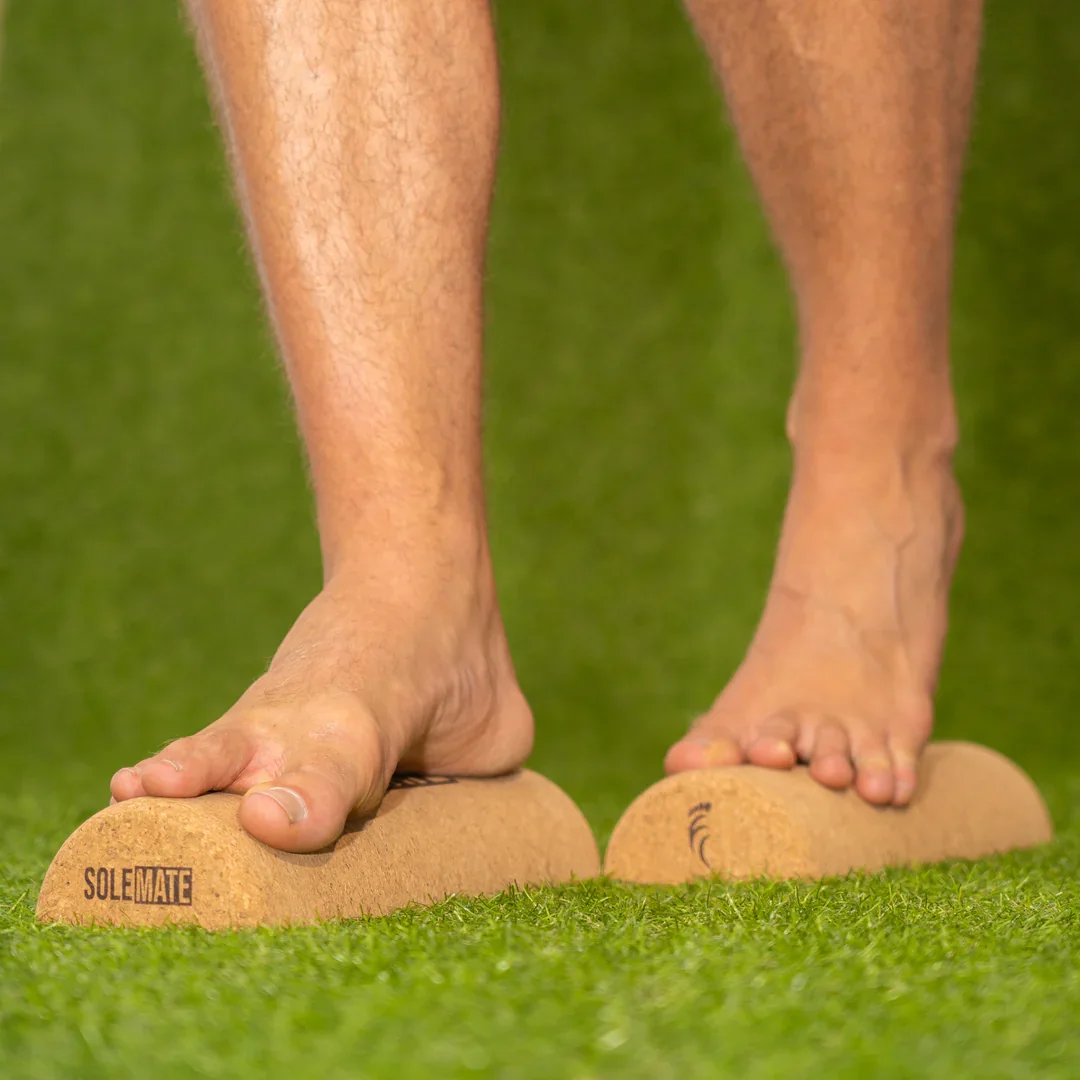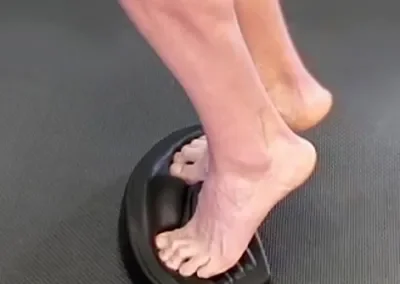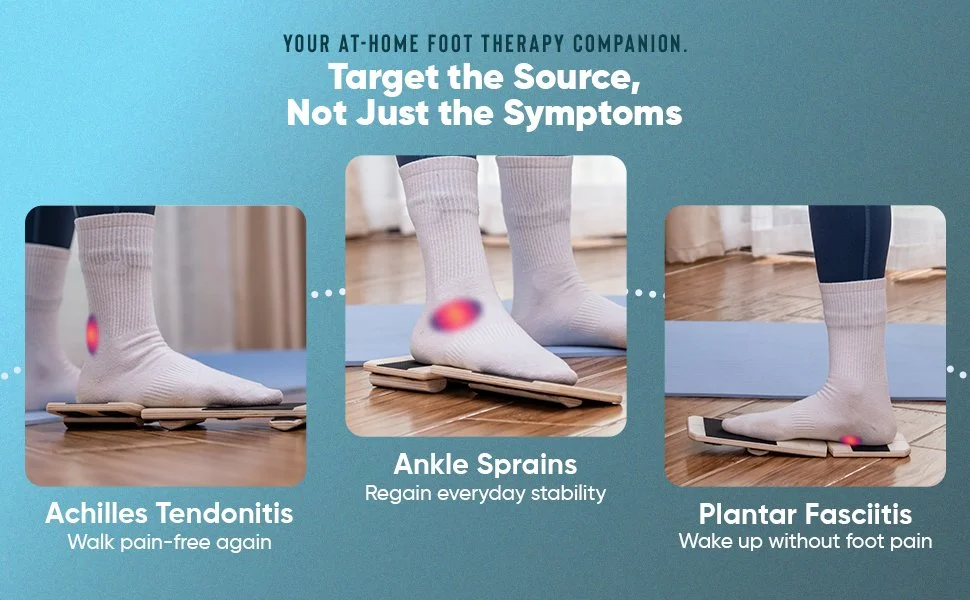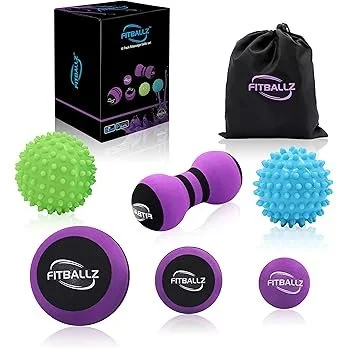The Best Foot Tools for Fascia, Alignment & Pain-Free Strength (And How to Use Them at Home)
Why Your Feet Matter More Than You Think
Your feet are the foundation of your entire movement system.
They are your body’s first point of contact with the ground and the starting point for every fascial, muscular, and postural chain above them.
When the feet become stiff, weak, or compressed:
the ankles lose mobility
the knees compensate
the hips overwork
the pelvis loses stability
the spine tightens
breathing becomes less efficient
Your fascia responds to this by gripping and bracing, pulling the body into subtle patterns of strain.
The good news?
You don’t need complicated programs or painful interventions to start changing your feet — just simple, intentional tools and consistent practice. Below are the tools I personally use and recommend to clients to support foot mobility, fascia health, posture, and pain-free strength.
1. The TFC Soulmate Foot Mobilization Tool
For: fascial release, foot decompression, arch adaptability, sensory awakening
The Soulmate is one of the most effective small foot tools I’ve ever used. It helps decompress the foot, hydrate the fascia, restore natural shape, and bring life back into areas that have been dormant for years.
Why it works
The Soulmate targets the plantar fascia, the midfoot, and the forefoot — the areas where most people develop tension, crowding, and compensatory gripping.
How to use it
Roll from heel → arch → forefoot
Pause anywhere tender
Breathe slow and deep
Spend 1–3 minutes per foot
Even a short session can change the way your foot feels inside your shoe, on the ground, and through your gait.
The Balance Beam Feature (My Favorite Part)
What surprised me most was the balance beam attachment.
I only have flat, predictable ground around my home — gym floors, sidewalks, hardwood. The beam introduced an entirely new shape for my foot to map and adapt to.
Standing on it felt incredible.
It encouraged my arches, toes, and lateral lines to reorganize instead of collapsing or gripping. You can feel your foot “wake up” and begin actively sensing the ground instead of relying on old patterns.
For anyone who lives on flat modern surfaces, this small shape variation is a game changer for proprioception, balance, and fascial hydration.
For: toe alignment, bunion support, balance, gait mechanics, deep intrinsic strength
Most people’s toes have been pushed together for years — shoes, sitting, tension, and immobility all contribute. When the toes lose space, the entire foot loses its ability to stabilize, absorb force, and communicate with the ground.
Toe Spacers (Passive Realignment)
Toe spacers help re-open the natural shape of the forefoot by teaching the toes to:
widen
anchor
stabilize the arches
support healthy pronation/supination
Start with 5–10 minutes a day, then build up as your toes adapt.
The Toe Band (Active Strength)
Where spacers help your toes open, the Toe Band helps them function.
The band trains the deep intrinsic muscles that control toe spread, toe pull, toe press, and arch activation.
It’s especially helpful for:
big toe weakness
collapsed arches
balance issues
bunion tendencies
stiff or under active pinky toes
Big-Toe Opening Band Drill
How to do it:
Loop the toe band around both big toes
Start with the toes together
Slowly pull the big toes apart against the band’s resistance
Keep your ankles stable and arches relaxed
This exercise helps retrain the medial line of the foot, improves big-toe abduction, and restores the functional movement bunions tend to restrict.
How to combine Toe Spacers + The Toe Band
For the best results:
Wear spacers for 5–10 minutes to create space
Remove spacers → perform 1–2 rounds of Toe Band drills
Finish with a short-foot or balance tool (like the Soulmate beam)
Mobility + strength = actual, lasting change.
For: Achilles health, calf–foot integration, big toe power, gait efficiency
The Toe Pro is incredible for people who feel disconnected from their big toe, Achilles, or inner arch. It trains the toes and calves as a unified system — something most modern movement patterns fail to do.
Recommended for:
plantar fasciitis
Achilles tightness
shin splints
weak push-off
stair climbing difficulty
balance challenges
You’ll feel this one immediately.
How to Use the Toe Pro (Simple + Foundational)
1. Start seated or lightly supported.
Place your toes on the first (lower) ledge with your heel on the ground.
This angle mimics the early push-off position in gait.
2. Press through your big toe.
Gently “push the ground away” with the big toe.
Avoid letting your arch collapse inward.
3. Lift the heel slightly.
As you maintain pressure through the big toe, lift your heel just enough to feel the inner arch and calf light up.
It should feel integrated, not max effort.
4. Slowly lower your heel.
Control the descent, the eccentric phase builds Achilles and foot resiliency.
5. Repeat 8–12 reps per side.
Focus on quality, not intensity.
Stop if your ankle wobbles or your arch collapses.
What you should feel:
big toe activation
inner arch lifting
calf + Achilles working together
improved stability through the whole foot
This is one of the best ways to rebuild functional arch support without gripping or overusing the toes.
Dive deeper into functional toe strength, gait mechanics, and how the toes influence your entire fascial system, you can read my full Toe Strength article here.
4. Ankle - Foot Training Board
For: intrinsic strength, arch control, foot-to-hip integration, balance
An ankle - foot training board helps you wake up the deeper layers of the foot that control subtle stability. Many people think they have “flat feet,” when in reality they simply have inactive feet.
This tool helps retrain your neuromuscular system to lift, spread, and stabilize through the arch.
Great for:
running
walking
lifting
balance
ankle stability
heel pain
* If you’re using the Ankle - Foot Training Board I linked, it also comes with video instructions, which makes it much easier to understand how the blocks work and how to get the most out of each foot–ankle drill.
5. Massage Balls (Soft, Firm, and Textured)
For: daily fascial hydration, sensory activation, tension relief
Simple but essential.
Different textures = different sensory input = different fascial responses.
Use for:
morning wake-up
post-walk release
mid-day decompression
grounding and sensory reset
The key is slow, intentional pressure — not smashing.
How These Tools Improve Fascia, Alignment & Whole-Body Tension
Each tool works through the same core mechanisms:
1. Fascial Hydration
Slow pressure rewets the tissue, improves glide, and decreases rigidity.
2. Sensory Awakening
Your feet contain some of your highest-density sensory nerve endings — activating them reorganizes posture upward.
3. Intrinsic Strengthening
Once the foot has space and mobility, strengthening becomes effortless.
4. Improved Gait Mechanics
When the foot adapts and responds to the ground, everything above it reorganizes:
hips
pelvis
spine
rib position
breath mechanics
This is why foot work changes your entire movement system.
A Simple Weekly Foot Routine
2–3 days per week:
Toe spacers (5–15 minutes)
Soulmate rolling (1–2 minutes/foot)
Toe Band activation (1–2 rounds)
Ankle - Foot Training Board or Toe Pro (optional)
Daily (optional):
Gentle spiky-ball massage
Slow calf mobility
A few breaths to reduce upper-body gripping
Closing Thoughts
You don’t need complicated systems to change your feet - you need consistency and the right tools.
Small daily inputs create massive long-term changes in:
posture
balance
pain
gait
energy
confidence in movement
Your feet are not separate from your body - they shape it.
Change your feet, and everything above them begins to reorganize.




